I say this all the time and it’s true: One of the most important tools in my studio is my 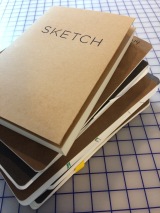 sketchbook. It’s the starting point for every quilt I create no matter how big or small. It’s my visual sandbox filled with unorganized pages of simple line drawings, notes and lists. My sketchbooks are not meant to be an end result in themselves. They’re just the beginning of my art making process and very often provide me with a roadmap to realizing a creative vision brainstormed on its pages.
sketchbook. It’s the starting point for every quilt I create no matter how big or small. It’s my visual sandbox filled with unorganized pages of simple line drawings, notes and lists. My sketchbooks are not meant to be an end result in themselves. They’re just the beginning of my art making process and very often provide me with a roadmap to realizing a creative vision brainstormed on its pages.
There are a lot of ways to use a sketchbook that go beyond drawing images that are perfect recreations of things that you see (which my sketches are definitely not!). I”m talking about using a sketchbook as a place to make lists, brainstorm ideas, explore techniques and yes even do some rough sketches of what you want your quilt to look like. There’s no right way or wrong way use a sketchbook. Whatever way works for you is the right way so experiment to find the one that works for you.
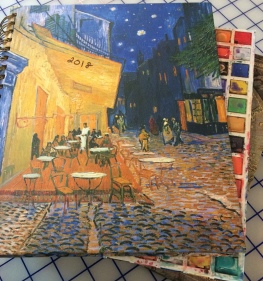
Whenever I start a new sketchbook I always write the year on the cover. Some sketchbooks cover more than one year and I like being able to reference what year the contents were created in.
For many years my preferred sketchbook was the 5” x 8” Riata softbound sketchbook by Daler Rowney but someone gave me an 8 1/2” x 11” sketchbook last year and I’ve found that I am liking the larger page. I tend to sketch my ideas fairly small (3″ to 5″ square) and the larger page gives me room for several sketches. I’ve bought a few hardcover ones from the local art supply store and they’ve become my new favorite.If you were to flip through my current sketchbook you’ll find pages of lists, scribbles, and really really rough sketches. Some with color added with either marker or colored pencil and some just in black and white. This is really my preferred way of working. I like to make lists of ideas for quilts and then break the lists further down into elements that I might want to include on them. When I draw something I don’t worry about making it look perfect because it’s just a starting point and no one is going to see it but me. Using a sketchbook saves me a lot of wasted time and fabric because It allows me to work through an idea to not only make sure it works but also to make sure that I like the idea and want to work with it. There are many ideas in my sketchbooks that have never made it past the sketchbook sandbox (at least not yet!) but most (not all) that have I have been very happy with the end results of.
Pages from my sketchbooks
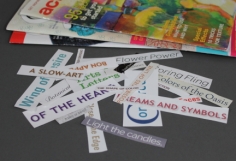
If sketching doesn’t appeal to you then try collage. Flip through old catalogs and magazines and tear out images, text and textures that appeal to you and then use a glue stick to paste them into a sketchbook. Organize your pages by theme: textures, colors, subject, shape etc. Now you have a reference book to flip through when you’re feeling uninspired and looking for new ideas.
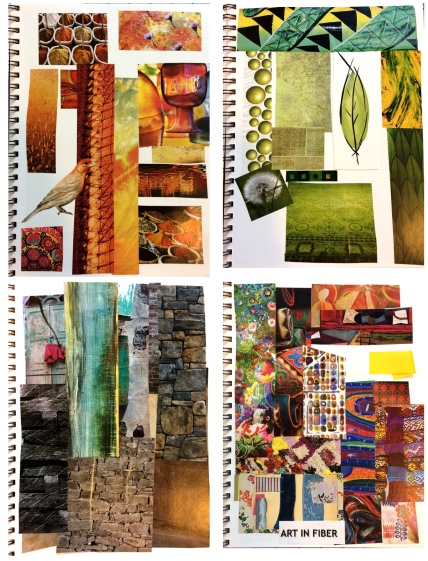
pages from my collage sketchbook
The world of digital photography makes it easy to snap an inspirational photo but I have 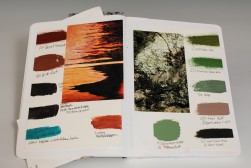 gigabytes of digital photos between my computer and my passport drives. Years ago I was working on a body of work around recreating textures in nature on fabric I printed the photos and pasted them into my sketchbook. It made it a lot easier to evaluate the colors and figure out what paints I wanted to use.
gigabytes of digital photos between my computer and my passport drives. Years ago I was working on a body of work around recreating textures in nature on fabric I printed the photos and pasted them into my sketchbook. It made it a lot easier to evaluate the colors and figure out what paints I wanted to use.
Don’t let the fear of not being able to draw perfectly hold you back from experiment with using a sketchbook. Find a method (or maybe more than one) that works for you and remember that the only person that needs to see what’s on the pages of your sketchbook is you!



I love this! I love creating art and drawing, my issue is where to get started sometimes. Thanks for being an inspiration!
LikeLiked by 1 person
This is a great idea! I need to get my art stuff more organized.
LikeLike
Pingback: looking back, moving forward |
You’re more organized than I am. Mine are whichever is closest and filled with all types of things.
LikeLike